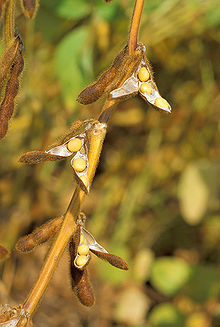Course:ECON371/UBCO2011WT1/GROUP2/Article 3 :The effects of Soya
http://www.peopleandplanet.net/?lid=29854§ion=34&topic=23
Summary
The demand for soya beans has doubled over the past decade creating the production to double as well. Soya is being used for food such as vegetable oil, meat, and feeding cattle it also is being used for biofuel. The U.S. has been the largest exporter of this product over the years and the largest importer has been China, but as of recently this agricultural good has been expanding in South America, to be more specific in areas such as Brazil. The production of Soya unfortunately does come with a cost. That cost being the destruction of the world’s natural habitat and it so happens to be that Brazil is responsible for 5 per cent of the biodiversity on earth. The deforestation that is going on to create farmland for soy is creating a massive amount of carbon dioxide emissions. Society has noticed these issues and is now just addressing them to minimize the effects of soy farming on the ecosystem. We have managed to create the Round Table for Responsible Soy (RTRS) this will help manage the deforestation that is happening in Brazil and around the world by enforcing standards in which soya is produced so is meets the efficient environmental standard.
Analysis
This article discusses a broad effect of expanding the plantation of soya beans. Because medication and standards of living has become better, the death rates are declining. Birth rates are increasing on average; therefore, the demand for food, such as soya beans, has increased over the past decade.
Based on the article, soya bean is a major compliment for agriculture. In order to raise farm animals, soya beans are their source of nutrients and because meat is on a higher demand as well, compliments such as soya beans, will inevitably increase. Thus, there is an increase in the price of soya beans on a supply and demand curve. As demand shift right or outwards, the price increases. But as the price increases, more suppliers are willing to shift their production into soya beans because of the increase in price and therefore, a chance for more profit, which is why South American countries had a boom in agricultural goods. Now the supply also shifted outwards to lower the price back to its original equilibrium, but the quantity increased that is if demand and supply shifted equally.
This however, generated another cost. By planting more soya beans, deforestation is required. Such process will decrease oxygen in the atmosphere, while the plantation of soya bean generates carbon dioxide in its growth process. The benefits of soya bean plantation are the chances of making revenue by selling soya beans and the woods chopped down. However, most people overlook a big external cost of such process; the excess carbon dioxide released into the atmosphere which will cause the Earth to warm up. The cost of cleaning the atmosphere is a number much greater than the revenue of all soya beans sold. Another cost is the deforestation that will reduce the size of the ecosystem which is abundant in wildlife. Some animals and/or organism are also endangered species. This ecosystem contains 5% of the total world biodiversity and losing it would be significant. To figure out the cost of the loss in biodiversity a willingness to accept analysis would probably be the most effective technique.
Even though the UK implemented the Round Table for Responsible Soy as a regulation to protect the forest in South America, but based on the article, it proves to be ineffective, which is logical. Food is a necessity to survive. Therefore, most people would not give up their lives to protect the forest. For this regulation to become more effective people will need actual incentives to change their dietary choices. A tax on soy products would be an effective way for people to choose different products and reduce the quantity of soya needed to be farmed and therefore the emissions and loss of habitat from deforestation.
Another effective technique to reduce this environmental damage could be to introduce a standard of which soy farms have to follow regarding amount of forest available to farm in or protect certain areas. By limiting the area for farming the biodiversity in the ecosystem would be sustained for future generations.
The use of soy to develop new biofuels is a perfect example of a project designed to better the environment with a large negative externality. The increase in soy farming for the use of the development of this fuel is emitting CO2 emissions which it was trying to reduce. If this fueling source was to be continued a cost benefit analysis should be done to see if the cost of reducing the biodiversity and the emissions from the farming of soy is less than the benefit from creating the new fuel.
With the increase of the population more food will continually be needed so more efficent farming methods are needed to increase the quantity of food without destroying more valuable habitat. By putting money into research and development and implementing standards for the most economically acheivable and efficent technologies this may be able to be achieved.
Profs Comments
Some good ideas. A bit confusing in places though.
8.5/10
